1. Undeployed driver airbag safety information
1. Precautions for transporting an undeployed airbag
Caution
- Take extra care when handling and storing an undeployed airbag.
- If the airbag deploys, materials on the surface of the airbag may scatter due to the sudden generation of gas.
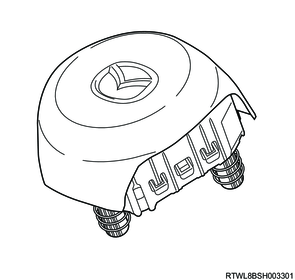
Warning
- When transporting an undeployed airbag, make sure that the airbag opening is facing away from your body.
- This is in order to minimize injury in case the airbag deploys.
- Do not carry the airbag by holding the wiring or connector.
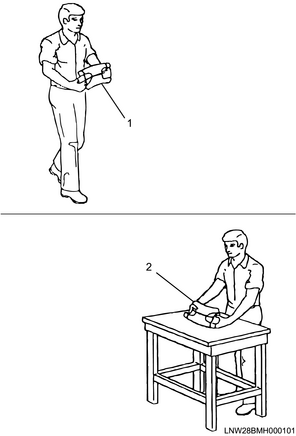
Legend
- When transporting an undeployed airbag, make sure that the trim cover is facing outward.
- When placing an undeployed airbag, make sure that the trim cover is facing upward.
2. Procedure for transporting an undeployed airbag
1) Service personnel should refer to the latest Service Bulletins for proper airbag transport procedures.
3. Precautions regarding the airbag scrapping procedure
During the course of a vehicle's service life, certain situations may arise which will necessitate the disposal of an undeployed airbag.
The information provided here applies to the proper procedure for disposing of an undeployed airbag.
The airbag may be deployed either inside or outside the vehicle.
Caution
- An undeployed airbag must not be disposed of through normal refuse channels.
- An airbag must be deployed before disposal.
- Failure to follow the proper disposal procedure can result in injury due to airbag deployment.
- Failure to dispose of in accordance with the proper disposal procedure may be a violation of federal, state, or local laws.
2. Deployed driver airbag safety information
Caution
- Be sure to wear gloves and safety glasses when handling an airbag after deployment.
- When handling the airbag, the safety precautions must be observed.
- The surface of the deployed airbag may contain a small amount of sodium hydroxide.
- This is a byproduct of the deployment reaction, and may cause irritation if it comes in contact with the skin or eyes.
- Wash hands with soap after handling.
3. Driver airbag (deployment outside vehicle) (method of securing to tire) scrapping
1. Outside vehicle deployment precautions
Caution
- When deploying an undeployed airbag outside the vehicle, the deployment procedure must be strictly followed.
- Continue to wear safety glasses until the deployed airbag is disposed of.
- Before performing the disposal procedure, you should be fully familiar with SRS repairs and with proper handling of the airbag.
- Go over the procedure carefully before beginning work.
- Use SRS deployment harnesses 5-8840-3165-0 and 5-8840-3190-0 for this procedure.
Note
- SRS deployment harnesses 5-8840-2468-1 and 5-8840-2881-1 can also be used.
- When using SRS deployment harnesses 5-8840-2468-1 and 5-8840-3190-0, replacement harness 5-8840-3167-0 is required.
Caution
- The procedure must not be performed when the SRS deployment harness is not available.
Warning
- Failure to follow the proper disposal procedure can result in injury.
- Do not connect the SRS deployment harness to any power supply before connecting to the driver airbag.
- Keep the deployment harness short-circuited until the moment when the airbag is to be deployed.
- The airbag will immediately deploy when connected to a power supply.
2. Driver airbag deployment procedure
1) Wear safety glasses.
2) Remove the driver airbag from the steering wheel.
Refer to "8.Restraints 8B.Airbag Systems driver airbag removal".
Warning
- When transporting an undeployed airbag, make sure that the trim cover is facing away from your body.
- When placing an undeployed airbag, make sure to face the trim cover upward.
- Facing the trim cover upward provides the airbag with space for it to expand in the event of an accidental airbag deployment.
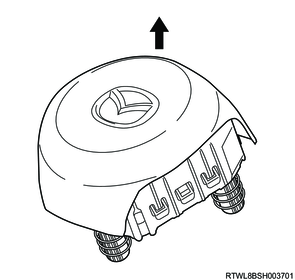
3) Inspect the SRS deployment harness for damage.
Note
- If the harness is damaged, discard it and obtain a new one.
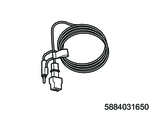
SST: 5-8840-3165-0 - SRS deployment harness and appropriate pigtail adapter
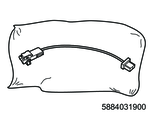
SST: 5-8840-3190-0 - SRS Deploment harness
4) Short the 2 SRS deployment harnesses together by securely inserting one banana plug into the other.
Caution
- The SRS deployment harness should be kept short-circuited and should not be connected to a power supply until the moment when the airbag is to be deployed.
Warning
- Connecting the deployment harness to the power supply should always be the last step in the airbag deployment procedure.
- If this procedure is not followed correctly, there is a risk of injury.
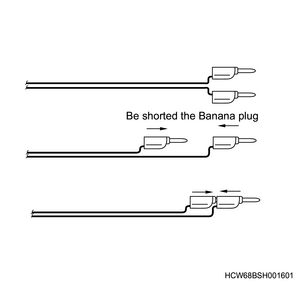
5) Connect the SRS deployment harness.
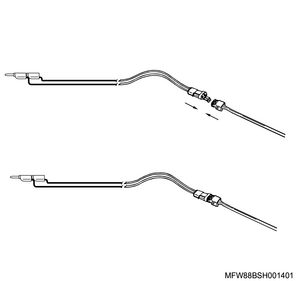
6) Clear a space on the ground about 2 m (6.6 feet) in diameter where the airbag is to be deployed.
Note
- An outdoor location on a paved road where people do not pass is preferred.
- If an outdoor location is not available, select a space on the shop floor where people do not pass and where there is sufficient ventilation.
7) Ensure that no loose or flammable objects are within the deployment area.

8) Prepare 3 tires (15 inch or larger) without wheels, and 2 tires of the same size with wheels.
9) Connect the SRS deployment harness to the air bag.
10) Verify that the SRS deployment harness is securely installed to the airbag.
Caution
- Keep the deployment harness short-circuited until the moment when the airbag is to be deployed.
11) Secure the airbag to the tire with wheel, with the trim cover facing upward.
12) In 2 locations, wind the automotive wire harness (with a cross-section of 1.25 mm2 or more) or fix with wire.
Caution
- Do not wrap around the deployment surface.
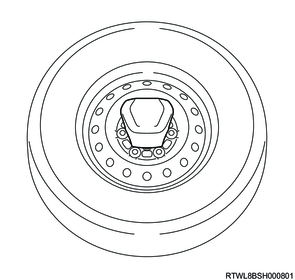
13) Pile up the tires as shown in the illustration.
14) Secure firmly using ropes at 4 locations to prevent the tires from tumbling down.
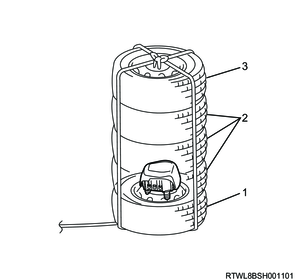
Legend
- Tire for securing airbag
- Tire without wheel
- Tire with wheel
15) Stretch the SRS deployment harness from the airbag to its maximum length.
16) Place a power source near the shorted end of the SRS deployment harness.
Note
- A vehicle battery of minimum 12 V and minimum 2 A is recommended as the power supply.
17) Confirm that no people or loose or flammable objects are present in the area around the airbag.
18) Verify that the airbag is placed with its trim cover facing up.
19) Notify all persons in the nearby area that an airbag will be deployed.
Caution
- The deployment will be accompanied by a very loud noise which may startle persons who are not expecting it.
20) Separate the 2 banana plugs on the SRS deployment harness.
21) Again, notify all persons in the nearby area that an airbag will be deployed.
Note
- When the airbag deploys, it may jump approx. 30 cm (1 feet) vertically. This is because the gas inside the airbag expands violently.
22) Connect the SRS deployment harness to the power supply to deploy the airbag.
Warning
- The airbag will immediately deploy when connected to a power source.
23) Disconnect the SRS deployment harness from the power supply.

24) Short the 2 SRS deployment harnesses together by securely inserting one banana plug into the other.

25) In the event that the airbag is not deployed after following this procedure, immediately go to 3. Procedures to be taken in case the airbag is not deployed.
Caution
- Wear a pair of shop gloves and safety glasses to protect your hands and eyes from possible irritation and heat when handling the deployed airbag.
Warning
- When handling a deployed airbag, safety precautions must be followed.
- Do not touch the metal parts of the airbag for about 30 minutes after deployment.
- Wait for the inflator module to cool.
- Do not place a deployed airbag near flammable objects.
- If this procedure is not followed correctly, there is a risk of injury.
- If the deployed airbag needs to be moved before it cools down, be sure to wear gloves and avoid touching any metal surfaces.
26) Disconnect the SRS deployment harness from the airbag.
Caution
- Disconnect the SRS deployment harness from the airbag as soon as possible after deployment in order to avoid damaging the SRS deployment harness.
27) Inspect the SRS deployment harness for damage, and replace if necessary.
28) Dispose of the deployed airbag through normal refuse channels.
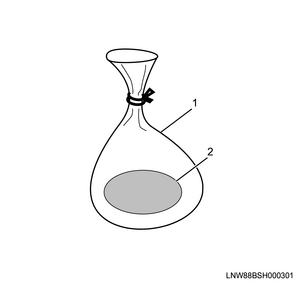
Legend
- Sturdy vinyl bag
- Deployed airbag
Caution
- Wash hands with soap after handling.
3. Procedures to be taken in case the airbag is not deployed
The following is the procedure to be taken in case the airbag is not deployed during the above procedure.
1) Disconnect the SRS deployment harness from the airbag.
Warning
- When transporting an undeployed airbag, make sure that the trim cover is facing away from your body.
Caution
- When placing an undeployed airbag, make sure to face the trim cover upward.
Warning
- Facing the trim cover upward provides the airbag with space for it to expand in the event of an accidental airbag deployment.
2) When no malfunction can be found in the SRS deployment harness, inspect the battery power supply, etc. If there are no problems, perform the airbag deployment again according to the Driver airbag deployment procedure.
3) When no malfunction can be found in the SRS deployment harness, inspect the battery power supply, etc. If there are no problems, perform the airbag deployment again according to 2. Driver airbag deployment procedure.
4. Driver airbag (deployment inside vehicle) scrapping
Deploying inside the vehicle is effective when the vehicle is being scrapped or when recovering parts that can be reused.
This includes, but is not limited to, the following situations.
| 1 |
The vehicle has completed its useful life. |
| 2 |
Vehicles that were involved in accidents from which they could not be repaired, but the airbag did not deploy. |
| 3 |
Vehicles stripped or damaged beyond repair by theft. |
| 4 |
Collection of reusable components. |
1. In vehicle deployment precautions
Warning
- Never use SRS components from one vehicle in another vehicle.
Caution
- When deploying an undeployed airbag inside the vehicle, the deployment procedure must be strictly followed.
- Continue to wear safety glasses until the deployed airbag is disposed of.
- Before performing the disposal procedure, you should be fully familiar with SRS repairs and with proper handling of the airbag.
- Go over the procedure carefully before beginning work.
- Use SRS deployment harnesses 5-8840-3165-0 and 5-8840-3190-0 for this procedure.
Note
- SRS deployment harnesses 5-8840-2468-1 and 5-8840-2881-1 can also be used.
- When using SRS deployment harnesses 5-8840-2468-1 and 5-8840-3190-0, replacement harness 5-8840-3167-0 is required.
Caution
- The procedure must not be performed when the SRS deployment harness is not available.
Warning
- Failure to follow the proper disposal procedure can result in injury.
- Do not connect the SRS deployment harness to any power supply before connecting to the driver airbag.
- Keep the deployment harness short-circuited until the moment when the airbag is to be deployed.
- The airbag will immediately deploy when connected to a power supply.
2. Driver airbag deployment procedure
1) Remove all loose objects from the front seats.
2) To reduce the risk of personal injury from vehicle glass or pieces of the interior, cover the windshield area, and the front door window opening completely with a drop cloth, blanket, or similar item.
3) Wear safety glasses.
4) Inspect the SRS deployment harness for damage.
Note
- If the harness is damaged, discard it and obtain a new one.

SST: 5-8840-3165-0 - SRS deployment harness and appropriate pigtail adapter

SST: 5-8840-3190-0 - SRS Deploment harness
5) Short the 2 SRS deployment harnesses together by securely inserting one banana plug into the other.
Caution
- The SRS deployment harness should be kept short-circuited and should not be connected to a power supply until the moment when the airbag is to be deployed.
Warning
- Connecting the deployment harness to the power supply should always be the last step in the airbag deployment procedure.
- If this procedure is not followed correctly, there is a risk of injury.

6) Connect the SRS deployment harness.

7) Remove the driver airbag from the steering wheel.
Refer to "8.Restraints 8B.Airbag Systems driver airbag removal".
8) Connect the SRS deployment harness to the air bag.
Caution
- Verify that the SRS deployment harness is securely installed to the airbag.
- The SRS deployment harness should be kept short-circuited and should not be connected to a power supply until the moment when the airbag is to be deployed.
Warning
- The airbag will immediately deploy when connected to a power supply.
9) Install the driver airbag to the steering wheel.
Caution
- Be careful the SRS deployment harness is not pinched by other components.
- Verify that the inside of the vehicle and area around the vehicle are clear of all people and loose or flammable objects.
10) Stretch the SRS deployment harness from the airbag to its maximum length.
11) Place a power source near the shorted end of the SRS deployment harness.
Note
- A vehicle battery of minimum 12 V and minimum 2 A is recommended as the power supply.
12) Notify all persons in the nearby area that an airbag will be deployed.
Caution
- The deployment will be accompanied by a very loud noise which may startle persons who are not expecting it.
13) Separate the 2 banana plugs on the SRS deployment harness.
14) Again, notify all persons in the nearby area that an airbag will be deployed.
15) Connect the SRS deployment harness to the power supply to deploy the airbag.
Warning
- The airbag will immediately deploy when connected to a power source.
16) Disconnect the SRS deployment harness from the power supply.
17) Short the 2 SRS deployment harnesses together by securely inserting one banana plug into the other.

18) Remove the cover which was fitted to the windshield and the front door window.
19) In the event that the airbag is not deployed after following this procedure, go to 3. Procedures to be taken in case the airbag is not deployed.
Caution
- Wear a pair of shop gloves and safety glasses to protect your hands and eyes from possible irritation and heat when handling the deployed airbag.
Warning
- When handling a deployed airbag, safety precautions must be followed.
- The metal parts of the airbag after deployment will be extremely hot.
- Do not touch the metal parts of the airbag for about 30 minutes after deployment.
- Wait for the inflator module to cool.
- If this procedure is not followed correctly, there is a risk of injury.
- If the deployed airbag needs to be moved before it cools down, be sure to wear gloves and avoid touching any metal surfaces.
20) Remove the airbag from the steering wheel.
21) Disconnect the SRS deployment harness from the airbag.
Caution
- Disconnect the SRS deployment harness from the airbag as soon as possible after deployment in order to avoid damaging the SRS deployment harness.
22) Inspect the SRS deployment harness for damage, and replace if necessary.
23) Dispose of the deployed airbag through normal refuse channels.

Legend
- Sturdy vinyl bag
- Deployed airbag
Caution
- Wash hands with soap after handling.
3. Procedures to be taken in case the airbag is not deployed
1) Disconnect the SRS deployment harness from the airbag.
2) Inspect the SRS deployment harness, and if a malfunction is found, replace it. Perform the airbag deployment again according to 2. Driver airbag deployment procedure.
3) When no malfunction can be found in the SRS deployment harness, inspect the battery power supply, etc. If there are no problems, perform the airbag deployment again according to 2. Driver airbag deployment procedure.